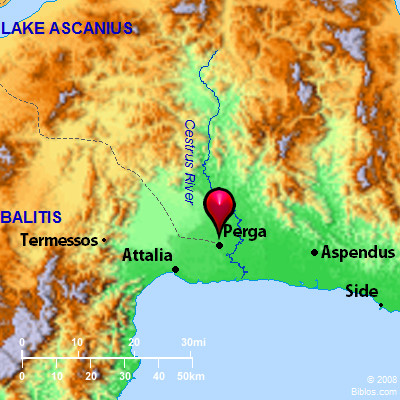Encyclopedia
PERGApur'-ga (Perge):
1. Location and History:
An important city of the ancient province of Pamphylia, situated on the river Cestris, 12 miles Northeast of Attalia. According to Acts 13:13, Paul, Barnabas and John Mark visited the place on their first missionary journey, and 2 years later, according to Acts 14:24, 25, they may have preached there. Though the water of the river Cestris has now been diverted to the fields for irrigating purposes, in ancient times the stream was navigable, and small boats from the sea might reach the city. It is uncertain how ancient Perga is; its walls, still standing, seem to come from the Seleucidan period or from the 3rd century B.C. It remained in the possession of the Seleucid kings until 189 B.C., when Roman influence became strong in Asia Minor. A long series of coins, beginning in the 2nd century B.C., continued until 286 A.D., and upon them Perga is mentioned as a metropolis. Though the city was never a stronghold of Christianity, it was the bishopric of Western Pamphylia, and several of the early Christians were martyred there. During the 8th century under Byzantine rule the city declined; in 1084 Attalia became the metropolis, and Perga rapidly fell to decay. While Attalia was the chief Greek and Christian city of Pamphylia, Perga was the seat of the local Asiatic goddess, who corresponded to Artemis or Diana of the Ephesians, and was locally known as Leto, or the queen of Perga. She is frequently represented on the coins as a huntress, with a bow in her hand, and with sphinxes or stags at her side.
2. The Ruins:
The ruins of Perga are now called Murtana. The walls, which are flanked with towers, show the city to have been quadrangular in shape. Very broad streets, running through the town, and intersecting each other, divided the city into quarters. The sides of the streets were covered with porticos, and along their centers were water channels in which a stream was always flowing. They were covered at short intervals by bridges. Upon the higher ground was the acropolis, where the earliest city was built, but in later times the city extended to the South of the hill, where one may see the greater part of the ruins. On the acropolis is the platform of a large structure with fragments of several granite columns, probably representing the temple of the goddess Leto; others regard it as the ruin of an early church. At the base of the acropolis are the ruins of an immense theater which seated 13,000 people, the agora, the baths and the stadium. Without the walls many tombs are to be seen. E. J. Banks
PER'GA, capitol of Pamphylia, on the river Cestrus, about 7 1/2 ms. from the Mediterranean, now called Eski Kalessi, "old castle," 225 ms. e.s.e. of Smyrna, and 10 ms. from the sea, 85 ms. s. from Antioch of Phrygia. Its seaport was Attalia, about 16 ms. s. w.
Strong's Greek
G4011: PergPerga, a city of Pamphylia




